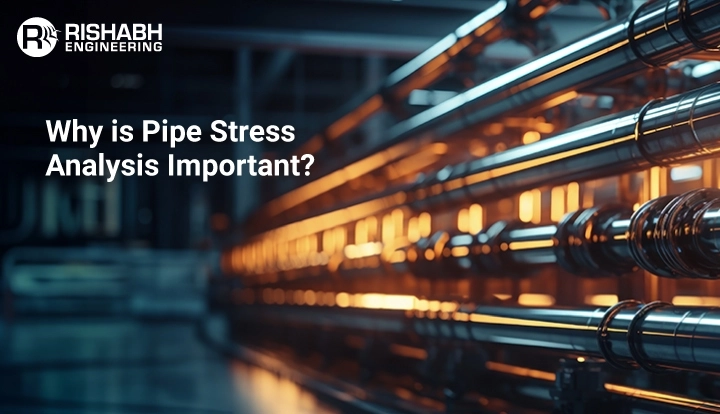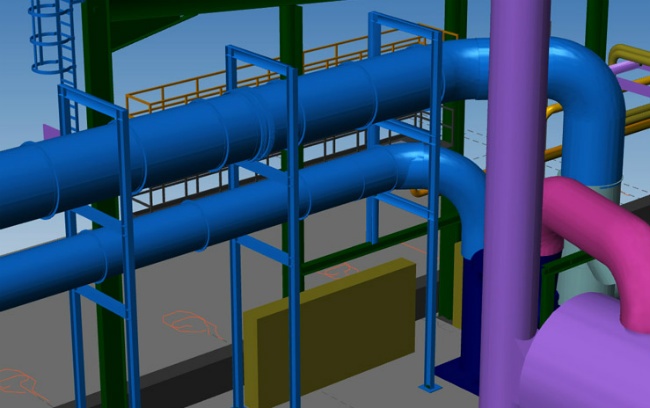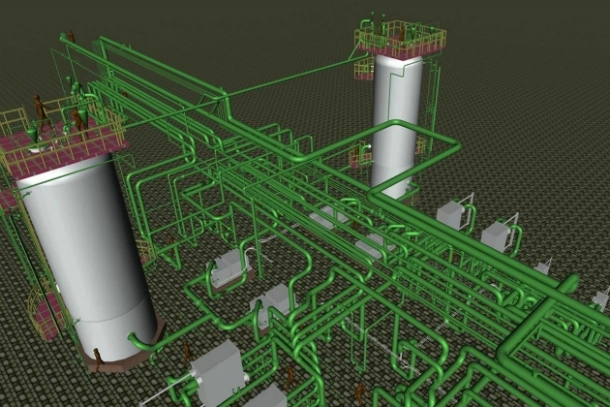
What Is Piping Stress Analysis – Benefits, Types, Industry Use Cases
Piping stress analysis is an important task to ensure piping systems’ safety, dependability, and integrity in plant engineering. It is essential for designing, constructing, and maintaining piping structures that transport liquids and gases at varied temperatures and pressure levels. In this blog we will examine the concept of piping stress analysis, its types, why to perform it, when is it required, and industry use cases with real life applications.

What is Pipe Stress Analysis?
Pipe stress analysis studies piping systems to verify their strength, safety, and efficiency. This entails utilizing computer software and human computations to determine pipework stresses, strains, and displacements under various loading circumstances. Such circumstances include internal pressure, thermal expansion, pipe weight and fluid flow, seismic events, and other external forces across various industries, including oil and gas, petrochemicals, and power production. The purpose is to identify probable failure causes, such as excessive stress, vibration, or thermal expansion, and then design ways to limit those risks.
Why is Pipe Stress Analysis Important?
Understanding why pipe stress analysis is so important exposes how it protects operational safety, assures regulatory compliance, and preserves the integrity of complicated piping systems. The following points emphasize the specifics:
- Safety: Safety is a top priority in industrial settings for both personnel and the general public. Fluids transported by piping systems can be dangerous if released into the environment. A plumbing system failure can result in explosions, fires, and the release of dangerous substances. Stress analysis can help to avoid such catastrophic breakdowns.
- Regulatory Compliance: Piping systems must adhere to severe requirements in various industries. Stress analysis is frequently required by regulators to ensure that systems meet safety and environmental criteria.
- Operational Integrity: Designing piping systems to resist stress helps save unplanned downtime and costly repairs. This helps to ensure the facility’s overall operating integrity and reliability.
- Identifying and addressing possible concerns during design can considerably minimize expenses for retrofitting or repairing pipe systems post-installation.
Why Perform Pipe Stress Analysis?
Listed below are the key factors why you need to perform stress analysis of piping systems;
- Important to managing stresses in the pipe and fitting with allowable codes.
- To keep nozzle loadings on attached equipment within allowables set by manufacturers or recognized standards (API 610, API 617, the Hydraulic Institute, etc.).
- Maintaining stress levels within the ASME Section VIII permitted limits at pressure vessel piping connections.
- To calculate design loads for sizing supports and restraints.
- To assess piping displacements for potential clash detection.
- To help optimize piping design.
Types of Pipe Stress Analysis
Piping systems are essential to many industrial applications and are subject to various strains caused by pressure, temperature, vibrations, and periodic loads. These strains can substantially impact the pipeline’s integrity and function. Understanding the various forms of piping strains is essential for effective design and maintenance. Here, we explore five main categories of piping stresses and the types of loads that influence them.
Hoop Stress:
- Nature: Arises from uniform pressure applied internally or externally on the pipe.
- Impact: This type of stress can cause expansion or contraction in the pipe’s diameter and wall thickness. It is critical in determining the pipe’s ability to withstand internal or external pressures without failure.
Axial Stress:
- Causes: It is primarily due to thermal expansion, pressure forces, and external loads that restrict the pipe’s natural length changes.
- Material Influence: Different materials expand or contract at different rates when subjected to temperature or pressure changes. This variation makes this type of stress analysis crucial to ensure that the pipes can handle these changes without compromising structural integrity.
Bending Stress:
- Origin: Results from concentrated body forces (like those from valves) or occasional forces (such as those from seismic activity or high winds).
- Effects: This stress often occurs when pipes are forced to displace due to the growth or movement of connected equipment or adjacent piping systems. It is essential to manage bending stress to prevent excessive deformation or failure under operational conditions.
Torsional Stress:
- Description: It is induced by forces that create rotational moments around the pipe’s longitudinal axis.
- Implications: These rotational forces can twist the pipe, potentially leading to material fatigue or failure if not properly accounted for in the design and analysis phase.
Fatigue Stress:
- Formation: They result from the cumulative effect of repeated or fluctuating stresses over time.
- Impact on Systems: Over time, continuous exposure to varying stresses can weaken pipe materials, making them more susceptible to cracks and eventual failure. Monitoring and managing fatigue stress is vital for the long-term reliability of piping systems.
The Three Categories of Loads Influencing Pipe Stress
Primary or Sustained Stresses:
- Definition: These ongoing stresses result from regular operational loads such as internal pressure and weight.
- Standards: According to ASME standards, these sustained stresses typically account for about 55% of the allowable stress. Proper design must ensure these stresses remain within safe limits to avoid structural damage.
Displacement Stresses:
- Cause: They arise from changes in pipe position due to thermal expansion contraction or movement of the support structure.
- Management: Keeping these stresses between 80% to 90% of the allowable limits as per ASME guidelines is recommended. Introducing flexibility into the piping system, such as expansion joints or loops, can help manage these stresses effectively.
Occasional Stresses:
- Occurrence: These stresses are typically due to infrequent or short-duration events, including seismic activities, extreme wind conditions, or relief-thrust loads.
- ASME Provisions: ASME codes temporarily increase stress levels during these events. For instance, the code permits a 15% increase in stress if a wind event lasts less than 8 hours and occurs less than 800 hours per year. Similarly, a 20% increase is allowed for seismic events lasting less than an hour and occurring less than 80 hours per year. These provisions ensure that the piping system can withstand rare but severe stresses without failing.
Pipe Stress Analysis - Industry Use Cases
Piping stress analysis is critical across numerous sectors, each with its own requirements and challenges:
- Oil and Gas: This sector uses enormous pipeline networks to deliver crude oil, natural gas, and refined products. The pipelines work at high pressures and temperatures, making stress analysis critical for preventing leaks and failures.
- Chemical and Petrochemical: The said industry relies on piping systems to deliver potentially hazardous substances. Therefore, stress analysis is essential for ensuring the integrity of these systems, particularly considering the corrosive nature of many chemicals.
- Power Generation: Power plants’ steam pipe systems experience tremendous temperatures and pressures. It helps ensure the reliability of the abovementioned systems that are crucial to the plant’s operation.
- Pharmaceuticals: Stress analysis is critical for pharmaceutical product safety, purity, and quality, as piping systems help run sterile and non-sterile fluids.
- Food and Beverage: Pipe stress analysis aids in designing systems that are easy to clean and maintain, hence avoiding contamination.
- Water and Wastewater Treatment: The plants in this industry employ piping systems to convey water. Stress analysis guarantees that these systems can withstand the pressures and flows required for treatment procedures like transferring sludge and other materials.
When is Pipe Stress Analysis Required?
Several fundamental “rules of thumb” are listed below for pipe stress analysis. However, it is important to note that these guidelines are not intended to replace the expertise of an experienced engineer. Instead, they serve as a reference to help those with less experience understand key considerations and facilitate discussions with seasoned professionals. The application of stress analysis can vary significantly between industries, with some adopting more rigorous or simplified approaches.
Beyond any legal or contractual requirements, here are some general situations where stress analysis is typically applicable;
- When the system’s operating temperature is beyond 150oF, and the pipe diameter is 4 inches or larger. For temperatures over 300oF, even lines smaller than 4 inches should be analyzed.
- For pipes with a diameter greater than 12 inches, although some guidelines suggest this should apply to pipes above 8 inches.
- Any 2½ inches or larger pipe connected to rotating equipment or heat exchangers.
- Pipes 6 inches and larger that are connected to pressure vessels.
- Cryogenic piping systems.
- Piping that carries hazardous chemicals.
- Double-walled pipes where the temperature difference between the inner and outer pipe is 40oF or greater.
- Short runs of hot pipes that are anchored at both ends.
- Systems that, upon professional review, are found to lack sufficient flexibility.
- Complex systems with multiple branches.
- When seismic analysis is necessary.
Another commonly referenced guideline is “The 1500 Rule.” According to this rule, if the product of the nominal pipe size (in inches) and the operating temperature (in oF) is less than 1500, the line may not require formal stress analysis. For example, a 3-inch pipe at 400oF gives a product of 1200 (3 x 400), which suggests stress analysis might not be needed. Conversely, stress analysis is likely necessary if the product exceeds 1500, as in the case of a 4-inch pipe at 400oF (4 x 400 = 1600).
Further, it is crucial to remember that thermal stress can occur in both hot and cold piping systems. The greater the difference between the pipe’s operating temperature and the ambient temperature during installation, the more likely it is that stress analysis will be required.
When May Pipe Stress Analysis Not Be Required?
- The system duplicates a successful operating arrangement or can be judged adequate compared to a previously analyzed system. The comparison must be by a competent professional.
- No thermal growth (ambient temperature fluids), small diameter HVAC chilled water, and plumbing.
Codes & Standards for Pipe Stress Analysis
- ASME 31.1 – Power Piping, B 31.3 (Process Piping), 31.4 (Hydrocarbon pipeline), 31.8 (Gas Pipeline) 31.12 (Hydrogen piping and pipeline)
- ASME Section VIII – Pressure Vessels
- API 610 (Centrifugal Pumps), API 676 (Positive Displacement Pumps), API 617 (Centrifugal Compressors), API 618 (Reciprocating Compressors)
Use Cases of Rishabh Engineering – Pipe Stress Analysis
Case 1: Piping & Structural Stress Analysis Of Oil & Gas Metering Systems
Project: Structure & Piping Stress Analysis for Oil & Gas Metering Systems
Client: EU-based Metering Skids Supplier
Objective: Our team undertook a comprehensive structure and piping stress analysis project for oil & gas metering systems provided by a prominent metering skids supplier in Europe. The project aimed to deliver optimized solutions using CAESAR-II 2013 R1 and STAAD Pro V8i SELECT SERIES 6, ensuring robust pipe stress and structural integrity analyses. The team of three engineers meticulously evaluated and provided detailed outputs, including caesar analysis, flange leakage reports, trunnion calculations, stress usometrics, and section properties of skid members. Additionally, considerations for crane capacity and sling sizes during skid lifting and transportation tie-downs were meticulously addressed, ensuring safe and efficient operational deployment.
Case 2: Piping Stress Analysis For Glycol Processing System
Project: Pipe Stress Analysis & Support Node Number Marking For The Glycol Piping System Using CAESAR II
Client: A US-based EPC Contractor
Objective: Conducted piping stress analysis by marking support node numbers for the glycol piping system using CAESAR II software, adhering to ASME B31.3 standards. Our team completed this piping stress analysis project for the glycol processing system within a 3-month timeframe in the USA. The deliverables included comprehensive stress analysis reports and stress isometrics with detailed support node number markup, ensuring compliance with industry standards for optimal system reliability and safety.
Case 3: Stress Analysis Of Vacuum Jacketed Liquid Nitrogen Pipes Using CAESAR II
Project: Piping Stress Analysis Of Vacuum Jacketed Liquid Nitrogen Lines
Client: Cryogenic Gas Equipment And Systems Manufacturer
Objective: Conduct a comprehensive piping & structural stress analysis for vacuum jacketed liquid nitrogen lines with a design temperature of -320oF and pressure of 200 PSIG, utilizing Hexagon CAESAR II 2018 software. The project, undertaken for a leading North American manufacturer of cryogenic gas equipment and systems, aimed to ensure compliance with international codes and standards while preventing excessive stresses and maintaining structural integrity. Rishabh Engineering successfully delivered a detailed piping stress analysis report and CAESAR native files, ensuring all operational and safety requirements were met within the 16-week project duration.
Final Words
Pipe stress analysis is a fundamental engineering approach that significantly impacts pipe systems’ safety, efficiency, and dependability in various sectors. Our pipe stress analysis services help improve facility operational integrity, assure regulatory compliance, and ultimately protect the environment and public health by recognizing possible concerns before they lead to failure.
Seek Help With Pipe Stress Analysis?
Our experienced team conducts stress analysis across a variety of industrial piping systems to enhance safety & reliability.
Frequently Asked Questions (FAQ)
Q: What are the 5 Things About Pipe Stress That You Need To Know?
A: Listed below are the considerations about pipe stress that you must be aware of:
- Piping Considerations: Pipe stress can be caused by internal fluid pressure, temperature changes, external loads, equipment vibrations, and support settling. To avoid failures and leaks, each of these aspects must be thoroughly evaluated and considered during the design and operation of piping systems.
- Piping System Safety And Integrity: Compliance with industry norms and standards is required. Piping engineers must verify that their designs adhere to the rules and criteria ASME and other organizations established for designing, fabricating, installing, and maintaining piping structures. Specifically, codes such as ASME B31.1 are published for power piping and ASME B31.3 for process piping to regulate production and ensure safety.
- Stress Analysis Techniques: Various methodologies are used to analyze pipe stress and its impact on piping systems. Typical stress equations such as PR/t, F/A, and M/Z are used in most designs. Furthermore, finite element analysis (FEA) is an effective computational tool for simulating and evaluating the behavior of complicated pipe structures under varying loading circumstances. Hand calculations, computer-aided design (CAD) software, and advanced engineering techniques are utilized to forecast piping system stresses, deflections, and failure modes. Engineers can optimize piping system design, material selection, and layout by doing detailed stress assessments to reduce stress concentrations and increase performance.
- Support And Restraint Systems: Proper support and restraint systems are necessary to manage pipe stress and ensure structural integrity. Supports like hangers and anchors are purposefully placed to distribute loads, avoid excessive deflections, and reduce stress concentrations in important areas. Furthermore, expansion joints and flexible connections are used to accommodate thermal expansion and contraction without putting excessive strain on the piping components. Engineers can reduce pipe stress and improve piping system reliability by incorporating strong support and restraint systems.
- Lifecycle Management: Pipe stress changes with operating conditions, material qualities, and environmental considerations over the entire system’s duration. As a result, proactive lifecycle management solutions are required for monitoring and measuring pipe stress throughout the operational life of a piping system. This comprises regular inspection, maintenance, and integrity evaluation (using software/tools) to detect potential stress-related concerns, corrosion, fatigue, and other degradation mechanisms.
Related Blogs
Related Blogs
Piping Support Design and Engineering
Pipe support design is an important component of piping engineering…
Detailed Engineering of Piping Systems
Detailed engineering involves design, detail, engineering and layout of piping…


